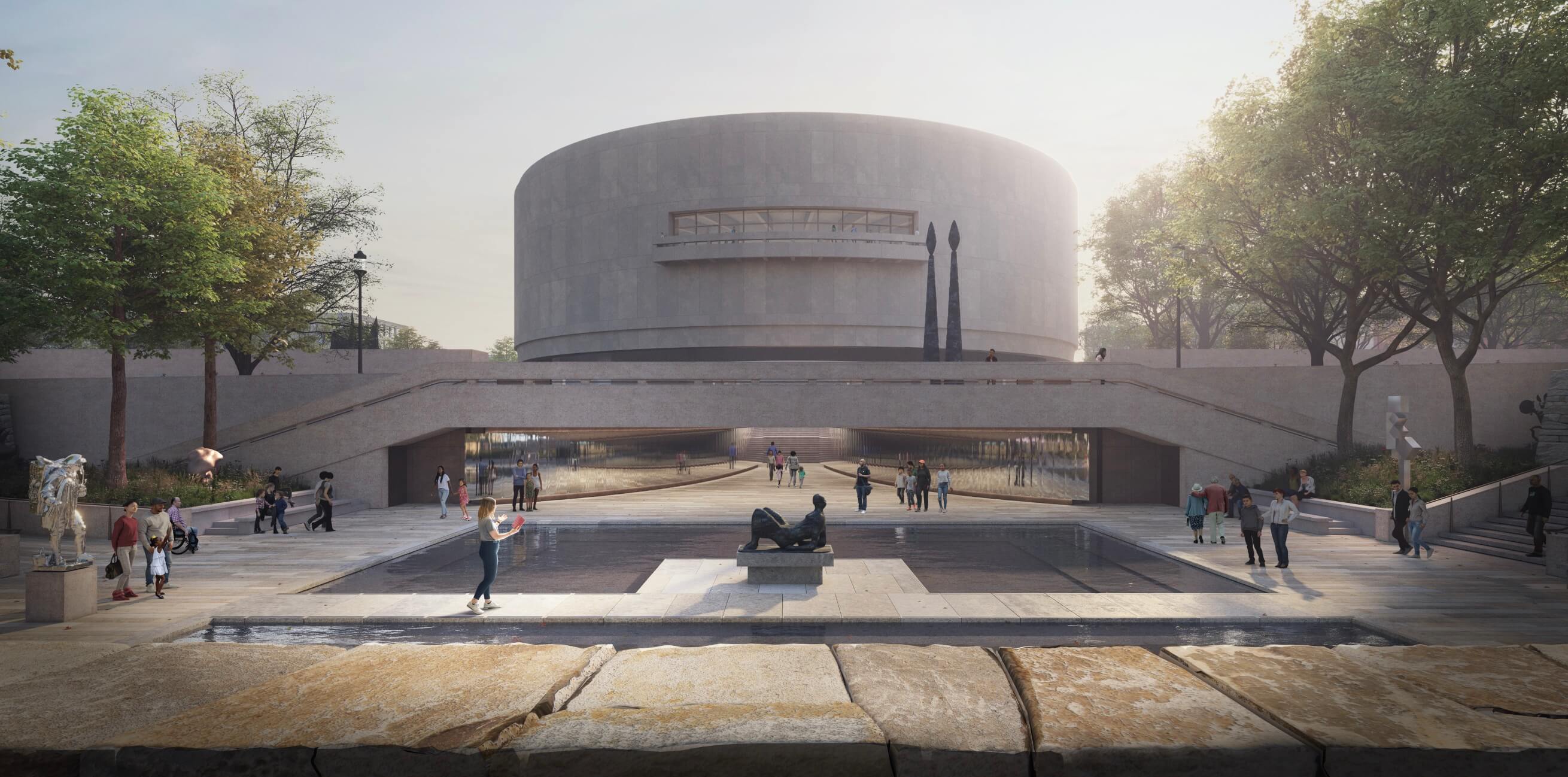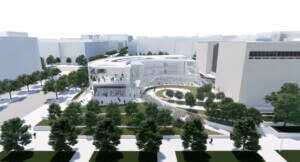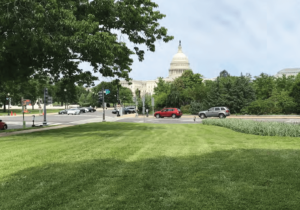Yesterday, the United States Commission of Fine Arts (CFA) granted final design approval to Japanese designer and photographer Hiroshi Sugimoto’s landscape revamp at the Smithsonian Institution’s Hirshhorn Museum and Sculpture Garden in Washington, D.C. Five commissioners voted to approve the plan and two voted against it.
Architect Billie Tsien, the newly elected chair of the commission who voted for its approval, called the design “sensitive, thoughtful, thorough” while describing the Smithsonian’s approach to the landscape revitalization as “how to make buildings and gardens live.”
Winning unanimous preliminary approval from the CFA and National Capital Planning Commission in 2019 after Sugimoto’s renovation of the main museum lobby, the overhaul of the Hirshhorn’s modernist landscape will be the second-ever comprehensive update of the Gordon Bunshaft-designed Hirshhorn campus, which originally debuted in 1974. In 1981, landscape architect Lester Collins oversaw a transformative and highly lauded redesign of the 2-acre sunken garden.
As for the latest redesign, Sugimoto leads a design team that includes his own firm, the Tokyo-based New Material Research Laboratory, Brooklyn’s YUN Architecture, the D.C. office of Quinn Evans Architects, and the Alexandria, Virginia-based landscape architecture and urban design studio Rhodeside & Harwell.
Plans for the garden overhaul—which have prompted a fair amount of controversy—promise to retain the ethos of the original design while adding long-overdue infrastructural improvements and enhanced amenities like substantially increased fixed seating and shade. Per the plans, the garden’s reflecting pool will be enlarged to better entice visitors from the National Mall, and a platform to stage performances and display sculpture, along with a sizable stretch of open lawn space, will also be added. It’s estimated that these improvements could help to boost Hirshhorn visitor numbers by a staggering 300 percent.
Improved accessibility and inclusivity is also a key component of the design. Beth Ziebarth, director of Access Smithsonian, applauded the CFA’s decision: “I have worked with the Smithsonian design team for over two years to review and improve Sugimoto’s final design,” she elaborated in a statement. “Key improvements include two accessible entrances and accessible paths throughout the garden. The revitalized Sculpture Garden will join the National Museum of Natural History and the National Air and Space Museum as facilities that provide universal access to our visitors. Universal accessibility is an overarching Institutional initiative to provide equitable access to all visitors wherever possible.”

The design calls for dry-stack stone walls, an element that represents perhaps the most significant alteration to the landscape. Per the museum, the stacked stone will be used to both improve acoustics and exhibit works across the garden and, in turn, are meant to dialogue with the sculpture garden’s existing concrete walls.
As noted by Washington, D.C.-based nonprofit The Cultural Landscape Foundation (TCLF), statements regarding the acoustical benefits of the stone wall previously touted by the museum are “generalized.” In March, TCLF requested that any formal studies conducted with regard to how the stacked stone walls will improve how sound travels throughout the garden be made public. Per the TCLF, the stack stone walls have been a major sticking point for Sugimoto—he reportedly threatened to walk away from the project if the walls were stricken from the design.
TCLF president and CEO Charles Birnbaum told AN in March that he has been “generally supportive” of the planned garden revitalization project with the exception of two issues. The advocacy- and education-focused organization has been “dogged” by seeing these issues addressed in a productive and transparent fashion: the stacked stone walls and preserving the “dignity of restraint” of the reflecting pool, which is in conversation with the single rectangular window of the building’s facade.
As Birnbaum wrote in a recent The Art Newspaper op-ed, in response to a wholly supportive letter written by Kerry Brougher, former chief curator and deputy director of the Hirshhorn Museum:
“Much of the proposed revitalization for the Sculpture Garden—long overdue—is to be commended. However, the Hirshhorn has failed to provide the programmatic justifications for the most consequential design interventions the CFA will be asked to approve: stacked stone walls and an expanded pool area in the historic core, alterations more radical than anything proposed for the museum building.
“We urge the commissioners to proceed cautiously, to carefully reevaluate the concept approval, and retain the unifed modernist composition created by architect Gordon Bunshaft.”
As Brougher wrote in his op-ed:
“The garden will be more visible if the Hirshhorn is allowed to move forward with a thoughtful and sensible renovation designed by the artist and architect Hiroshi Sugimoto. I cannot think of a better individual to take on this long-needed project. Through his 2006 Hirshhorn retrospective (which I co-curated with David Elliott) and his more recent reimagining of the lobby, Sugimoto thoroughly understands the building. He has a deep appreciation of old and new design, materials and composition, light and shadow, and a keen ability to balance the traditional with the progressive. In selecting Sugimoto, the Hirshhorn has identified not only an artist-architect but a bridgebuilder connecting the Modern with the contemporary.”
Yesterday’s vote during the nearly three-hour hearing, as mentioned, was for the project’s passing. Two commissioners, James McCrery and Duncan Stroik, voted against approving the proposed design. Both McCrery and Stroik are Trump administration appointees, while four of the commissioners who voted to approve the design—Tsien, Justin Garrett Moore, Hazel Ruth Edwards, and Peter D. Cook—were recently appointed by President Joe Biden to fulfill four-year terms. The CFA’s seventh member, Rodney Cook Mims, Jr. is the remaining Trump appointee, who joined the commission at the very end of the former president’s term. He voted in favor of Sugimoto design. (McCrery and Stroik, the longest-serving current commissioners, were both appointed in December 2019.)
While the current composition of the CFA is markedly more diverse than the classical-leaning, all-white-male commission that Trump had formed previously, it has come under scrutiny from organizations such as the American Society of Landscape Architects (ASLA) for being without a single landscape architect. The ASLA has implored the Biden administration to install one given that an estimated 70 percent of projects that come before the commission involve landscapes. Landscape architect Perry Guillot, the designer of Melania Trump’s headline-grabbing White House Rose Garden refresh, was among the four commissioners replaced by the Biden Administration in May. The Obama-era CFA, by comparison, had three: Liza Gilbert, Mia Lehrer, and Elizabeth Meyer. Earlier this month, Meyer wrote to CFA Secretary Thomas Luebke clarifying that she does not endorse the current design and urged the current commissioners to take particular care in reviewing the plan.
“[…] as a newly constituted board without a landscape architect, please appreciate that the particular comments you make about this project will signal a message about the importance of the DC cultural landscape to future CFA applicants and their design teams,” wrote Meyer in her letter. “I wish my former Commissioners and the newly appointed Commissions the best as you deliberate on this and future matters.”
Birnbaum believes the deficit of a landscape architect or multiple landscape architects on the commission contributed to the approval of Sugimoto’s garden revitalization plan:
“The Hirshhorn benefitted at the Commission of Fine Arts today from the commissioners’ lack of experience, the commissioner’s lack of understanding of Commission policies and procedures, and, because for the first time in some twenty years not one of the commissioners is a landscape architect, they benefited from the commissioners’ very evident lack of understanding of landscape architecture,” said Birnbaum.
A construction timeline has not been established yet at the time of writing.











